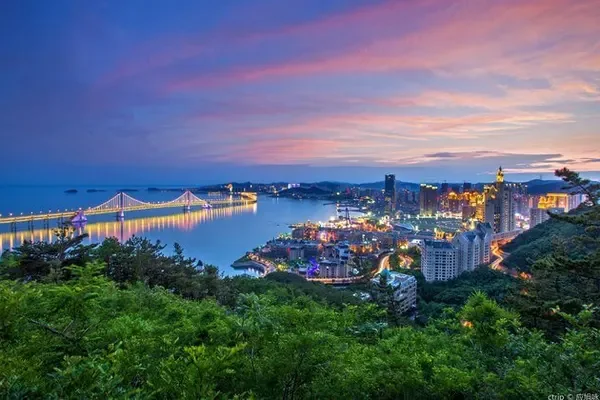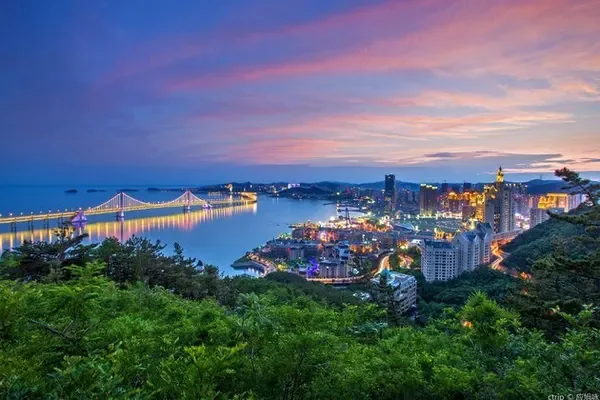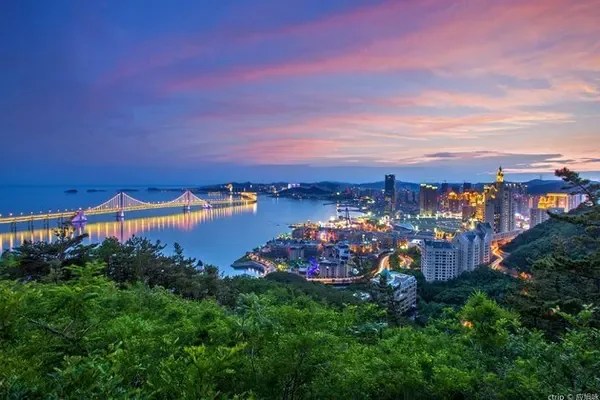
The Ming Tombs are located at the foot of Tianshou Mountain in Changping District, Beijing, with a total area of more than 120 square kilometers and about 50 kilometers away from Tiananmen. The Ming Tombs are located in a small basin surrounded by mountains on three sides in the east, west and north. The area around the tomb is surrounded by mountains, the central part is a plain, and there is a meandering river in front of the tomb. From the beginning of Changling in May of the seventh year of Yongle (1409) to the burial of Chongzhen, the last emperor of Ming Dynasty, in Siling, during more than 230 years, thirteen emperor tombs, seven concubine tombs and one eunuch tomb were built successively. A total of thirteen emperors, twenty-three empresses, two princes, more than thirty concubines, and two eunuchs were buried.

Two of the sixteen emperors of the Ming Dynasty were buried elsewhere, one was missing, and the other thirteen were buried in Tianshou Mountain, so it is called "Ming Tombs".

As of 2011, the "Ming Tombs" have opened attractions including Changling, Dingling, Zhaoling and Shenlu.

Ming Ding Mausoleum is the mausoleum of Zhu Yijun (reign name Wanli), the thirteenth emperor of the Ming Dynasty. His two queens are also buried here. The mausoleum is located at the foot of Dayu Mountain, southwest of Changling Mausoleum, and was built between 1584 and 1590 (the 12th year of Wanli to the 18th year of Wanli).

The Ming Tombs is the general name of the royal mausoleums of 13 emperors after the Ming Dynasty moved its capital to Beijing. There are Changling (Ming Chengzu), Xianling (Ming Renzong), Jingling (Ming Xuanzong), Yuling (Ming Yingzong) in sequence. , Maoling (Ming Xianzong), Tailing (Ming Xiaozong), Kangling (Ming Wuzong), Yongling (Ming Shizong), Zhaoling (Ming Muzong), Dingling (Ming Shenzong), Qingling (Ming Guangzong) , Deling (Ming Xizong), Siling (Ming Yizong).


The main buildings include Yan'en Gate, Yan'en Hall, Baocheng, Minglou and underground palaces. Covering an area of 182,000 square meters. It is the only one among the Ming Tombs that has been excavated. Dingling Underground Palace can be visited by tourists.


Along the central axis of the courtyard, there is a two-column archway gate (Lingxing Gate) and a set of Shijiyan. The two pillars of the archway gate are head-shaped, carved from white stone, with a square cross-section, a sitting dragon carved on the top, and stone drums on the front and back. Shijiyan is composed of stone offering tables and stone offering utensils. The stone offering table is in the Xumizuo style, and the stone offering utensils are composed of an incense burner (one), candlesticks (two), and vases (two).




Construction of Dingling Mausoleum began as early as Emperor Wanli's lifetime. Construction started in the 12th year of Wanli (AD 1584). It took 6 years to complete and cost 8 million taels of silver. The emperor was only 28 years old when the mausoleum was built, and it was not officially opened until 1620. Dingling has become one of the three largest cemeteries in the Ming Tombs. Its ground buildings occupy a total of 180,000 square meters, with three spacious courtyards in front and a tall treasure city in the back. In front of the main gate of the mausoleum is the white marble bridge of the three soldiers. After crossing the bridge is a tall stele pavilion. Around the pavilion, there are more than 300 buildings such as the Temple and Sacrifice Office, the Sacrifice Pavilion, and the Dingling Supervisor. Further behind is the outermost wall of the cemetery - Wailuo City (the wall outside the wall).

Ming Ding Mausoleum is the mausoleum of Zhu Yijun (reign name Wanli), the thirteenth emperor of the Ming Dynasty. His two queens are also buried here. The mausoleum is located at the foot of Dayu Mountain, southwest of Changling Mausoleum, and was built between 1584 and 1590 (the 12th year of Wanli to the 18th year of Wanli). The main buildings include Yan'en Gate, Yan'en Hall, Baocheng, Minglou and underground palaces. Covering an area of 182,000 square meters. It is the only one among the Ming Tombs that has been excavated. Dingling Underground Palace can be visited by tourists. The underground palace in Dingling is all made of stone, mostly bluestone, with an area of 1195 square meters. There is no beam frame inside, it is a stone arch coupon, which is quite tall. There are seven 4-ton white marble gates in the underground palace, which are ingeniously designed and flexible in opening and closing. The underground palace is divided into the main hall, side hall, and front hall, which are exactly the same as the buildings on the ground. The sacrificial utensils are displayed in the nave in its original state. There are three white marble seats, and in front of each seat there is a set of five offerings of yellow glaze and a large blue and white porcelain vat. The coffins of Zhu Xujun and two empresses were placed on the coffin beds in the apse, and 26 red-lacquered wooden boxes filled with funerary objects were placed beside the coffins.


The overall layout of the Mausoleum Palace is also in the shape of a circle in the front and a circle in the back. Its periphery is a "Wailuo City" that includes Baocheng and the front courtyard of Baocheng. In Wailuo City, the rear part is Baocheng. Before Baocheng, there were three square courtyards in Wailuo City.

In the mid-1950s, there was a wave of archaeological fever in the mainland. Some archaeological experts proposed to the central government to excavate several imperial tombs for research, and the experts quickly targeted Dingling, the tomb of Zhu Yijun, Emperor Wanli. superior. The central government agreed to the archaeological excavation of Dingling, but when the imperial tomb was excavated in 1956, a series of bizarre events followed. . .
Many people who directly participated in the excavation of the Dingling Mausoleum ended up in a very bad situation, and some even did not die well. What is known is that Wu Han, the deputy mayor of Beijing who advocated the excavation, had his family ruined and eventually committed suicide in prison. Before his death, his hair was pulled out. Everyone knows this. Zheng Zhenduo, who was in charge of the excavation, died in a plane crash while visiting Afghanistan and the United Arab Republic in 1958; Liu Dean, the photographer who opened the coffin, suffered a mental disorder and hanged himself; Bai Wanyu, an archaeological expert who participated in the excavation, lost his mind in his later years and died of a cerebral hemorrhage. . .

However, due to backward technology, it is easy to dig, but difficult to protect, and many rare treasures have been irreparably damaged. Zheng Zhenduo, then director of the State Administration of Cultural Heritage and director of the Institute of Archeology of the Chinese Academy of Sciences, and Mr. Xia Nai, the deputy director, immediately wrote to the State Council, requesting that the application for excavation of the emperor's tomb be stopped immediately, and Premier Zhou Enlai approved the application.
"After the excavation of Dingling, we came to a conclusion that the emperor's tomb cannot be dug casually." said Wang Zhongshu, a famous Chinese archaeologist who participated in the archaeological exploration of Dingling.




Since the tunnel gate of Baocheng is located in the right front of the Baocheng wall, the coffin of the empress must pass through the tunnel gate in Wailuo City, which can enter Baocheng, to be buried in Xuangong after holding the "San Shen Ceremony" in the Hall of Enjoyment (Zhenen Hall). At the same time, taking into account the symmetry of the architectural design, a wall-mounted tuck door is symmetrically installed on the left and right walls of the third entrance courtyard.







The excavation of Dingling was definitely a wrong decision. At that time, the country was still poor, and it was impossible to spare a large budget to preserve these cultural relics. Many precious cultural relics were even packed in cardboard boxes and piled up in the storage room of the research institute. year. A lot of easily carbonized silk fabrics were put in boxes randomly and then taken out. As a result, they soon turned black and became a pile of slag. At that time, many staff members were non-professionals. Some precious porcelains were played with in their hands when they were picked up, and they were damaged a lot inadvertently. It turned into ashes. The bones and coffin of Emperor Wanli were not spared, so it is inconvenient to say what happened here. It can be said that the excavation of Dingling is a great tragedy in the history of Chinese archaeology.

Fortunately, after the excavation of the Dingling Mausoleum, the relevant state departments realized that we did not have the conditions to excavate the imperial mausoleum at all. Later, Guo Moruo and others proposed a plan to excavate the Qianling Mausoleum (the joint burial mausoleum of Tang Gaozong Li Zhi and Wu Zetian), which was accepted. Premier Zhou refused. The country has also established a big iron law in the archaeological field, and will never allow the emperor's tomb to be easily excavated from now on.


